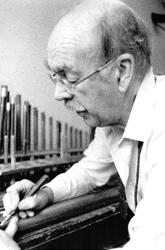
Henry Willis, IV, the last living family member of the Henry Willis & Sons organbuilding dynasty, died at a hospital near his home in India on June 23, at the age of 91. Willis was born January 19, 1927, to Henry Willis, III and Clara Constance (Sinclair) Willis at Streatham Hill, London. Educated at Gladstone Preparatory School, London, Westminster School, London, and Giggleswick School, North Yorkshire, he left school in 1944 to join the Royal Army during World War II. He was promoted to Lance Corporal in 1945 and commissioned to the Queen’s Royal Regiment in 1946, where he was placed in charge of a Japanese prisoner of war camp and the repatriation of British prisoners.
Willis joined the family organbuilding firm in 1948 as a laborer (at the insistence of his father) and then trained as a pipemaker and voicer under George Deeks. He was sent to manage the Liverpool Branch in 1954, principally to oversee the restoration of the great 1855 Willis concert organ in St. George’s Hall, which had been severely damaged by wartime bombing, theft, and general mishandling. He returned to London to manage the Head Office in 1965 due to his father’s worsening health. Following Henry Willis, III’s death on February 27, 1966, he began the search for property to construct a purpose-built organ factory in Petersfield, where he opened a shop in 1968 on land that had been the site of old dairy buildings.
Willis was invited to attend, and became one of the founding members of, the American Institute of Organbuilders at its first annual convention in 1974, thereby beginning a relationship with his American organbuilding colleagues. A frequent attendee and lecturer at subsequent conventions, his last appearance was in Washington, D.C., in 1993, where he lectured on and demonstrated organ pipemaking and voicing. His acerbic wit and entertaining style covered quite a bit of useful information to those who “listened between the lines” during those lectures and demonstrations. His wife, Barbara, was a charming lady who did her best to keep Willis as well-behaved as possible, especially during times set aside for evening socializing!
In 1997 Willis stood down as Managing Director of Henry Willis and Sons. New management and new ownership relocated the firm to the Liverpool Branch in 2001 where the firm now survives him. He was a Freeman of the City of London and served as Master of The Worshipful Company of Musicians, of which he was the longest holder of the Livery.
Henry and Barbara Willis moved to India in 2008 where his mother’s family had been coffee planters in the 19th and 20th centuries. They purchased land and built a house there, in which he and Barbara have lived up to the present. He died peacefully at home in the Nilgris District of Tamil Nadu.
—John-Paul Buzard


